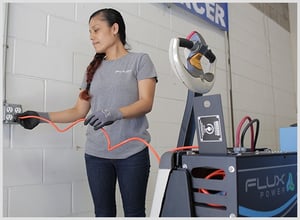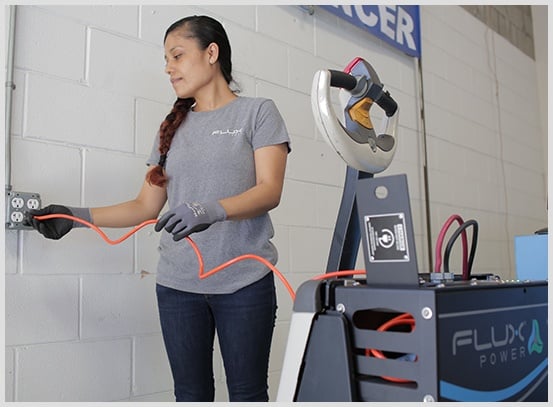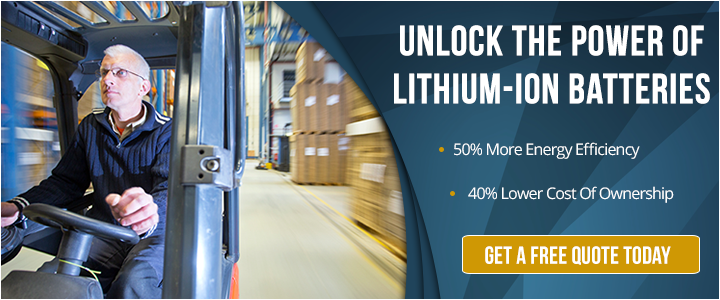Electric forklifts and other material handling equipment are generally powered by one of two different types of batteries … lithium-ion or lead acid.
The technology behind each type of battery differs significantly, impacting charging times and procedures.
When comparing the two, lithium-ion batteries have a charging process that is more efficient and provides substantial cost savings over time. Below we’ll explore how the lithium-ion battery charging process benefits businesses now and in the future.
Faster Charging
 One of the most convenient features of lithium-ion batteries is that they can be opportunity charged. This includes in between shifts, when workers take breaks or when any other opportunity presents itself.
One of the most convenient features of lithium-ion batteries is that they can be opportunity charged. This includes in between shifts, when workers take breaks or when any other opportunity presents itself.
That’s because lithium-ion batteries only take 1 to 2 hours to charge. That is in stark contrast to lead acid batteries, which take 8 hours to fully charge and another 8 hours to cool down.
At times, it can be inconvenient to charge a battery, no matter how convenient opportunity charging is. Because lithium-ion batteries can be safely discharged to a lower level than lead acid batteries, using lithium-ion batteries gives operators more leeway to charge the batteries when it’s convenient.
Lithium-ion batteries can be safely discharged down to 20% capacity, whereas lead acid batteries can only be safely discharged to 30% capacity.
No Cooling Down Period
Lithium-ion batteries are designed with the cells encased. This means that no water maintenance is required.
Companies that use lithium-ion batteries to power their fleets clearly have an advantage, as only 1 lithium-ion battery is required per forklift to operate 2 or 3 shifts in a 24-hour period, compared to 2 or 3 lead acid batteries per forklift.
Because lead acid batteries are filled with an electrolyte (sulfuric acid and water) solution that becomes extremely hot during charging, they require ample time to cool down after being charged.
A typical cool-down period for a lead acid battery is 8 hours, or the length of one shift. Because of the amount of time it takes to charge a lead acid battery and allow it to cool down, each forklift will require one lead acid battery per shift.
So, if your warehouse operates 24 hours per day, each forklift will require 3 lead acid batteries. A lead acid battery must be swapped out each shift. This is a time-consuming, labor-intensive process that should be factored into the true cost of the battery.
Simpler Charging Process
The process of charging a lithium-ion battery is not as complicated as that of a lead acid battery.
Lithium-ion batteries do not require separate charging rooms and do not need to be removed from the forklift or other material handling equipment in order to be charged. Instead, forklift operators can connect the battery to the charger while it is still in the forklift or other equipment.
The charging process is much more complex for a lead acid battery. Here’s what it looks like:
- When a battery needs charging, a forklift operator must drive the forklift to a designated battery charging room.
- Using special lifting equipment (because of the battery’s weight), trained personnel must then remove the battery and place it on a storage rack where the charging will be done.
- The battery is then charged for approximately 8 hours.
- Once the charging process is completed, the cooling down stage begins. This lasts an additional 8 hours.
- The battery will either remain where it was charged or personnel may transport it to a designated cooling area, if the space is needed in the battery room to charge other batteries.
- After the battery cools and is ready to go back into service, a worker may check the electrolyte levels and refill the battery with distilled or deionized water. Skipping this final step can cause the chemical process to degrade, and the battery will suffer an early failure.
Less Costly Over Time
 Implementing the use of lithium-ion batteries can save on labor costs, thanks to the easier and more labor-efficient charging process.
Implementing the use of lithium-ion batteries can save on labor costs, thanks to the easier and more labor-efficient charging process.
In fact, one major equipment manufacturer will save more than $1 million by switching to lithium-ion batteries.
That’s because the company was spending nearly $1.5 million each year simply swapping out the lead acid batteries it was using to power its fleet of 80 class I and II trucks.
After taking a closer look at its operations, the company discovered that it was spending approximately $4,800 every day on lost productivity associated with the removal and re-installation of batteries for charging. In addition, the replacement process of swapping out lead acid batteries twice per shift took the forklift out of service for approximately 15 minutes for each battery exchange.
Because lithium-ion batteries can be charged while in the forklift or other equipment, there is no need for the labor-intensive process of swapping out batteries for charging.
In addition, the square footage being used for a lead acid battery room can be repurposed for more productive usage.
Minimal Maintenance
Unlike lead acid batteries, lithium-ion batteries do not need to be watered. This saves time and manpower that can be used elsewhere in your operations.
A lithium-ion battery management system (BMS) also balances the cells automatically and offers several protections when a battery is charging. A battery management system:
- Maintains cell temperatures in the ideal operating range to prevent overheating or freezing.
- Monitors currents and voltage measurements to ensure both stay at safe levels.
- Prevents overcharging and the formation of dendrites, which can cause significant damage to lithium-ion batteries.
In lead acid batteries, water levels must be precisely controlled in several ways. In addition to topping off with water when fully charged and cooled down, crews must monitor the battery to ensure:
- Water levels do not drop too low that the top of the lead plates is exposed (about every 10 charge cycles)
- Water used must be between 5 and 7 on the pH scale
- Enough space is left for the liquids inside to expand, which occurs when the battery is in use
- The cells are equalized regularly and temperature is controlled throughout the charging process
Enhanced Safety
Lithium-ion batteries offer enhanced safety features to ensure that you are getting the most out of your battery, while protecting your employees at the same time.
As mentioned above, lithium-ion batteries do not require watering during the charging process. When workers add fluids to lead acid batteries, there is a risk of a spill occurring. In the event of a spill, highly-toxic sulfuric acid within the battery can splash onto the body or in the eyes, causing injury.
There is minimal risk of overheating in lithium-ion batteries during charging. The battery management system tracks cell temperatures to ensure they remain in safe operating ranges so there is no risk to employees. In lead acid batteries, the electrolyte solution can overheat, increasing pressure inside the battery and causing damage to the plates … or worse, causing an explosion.
Lithium-ion batteries also do not emit potentially harmful gases when charging. Lead acid batteries require separate, well-ventilated areas for charging because of the risk of this occurring.
Long-Term Outlook
The technology behind lithium-ion and lead acid batteries differs significantly and impacts every aspect of charging, including the amount of time it takes to charge a battery, the process, the maintenance that is required and the safety of workers.
All of these factors produce hidden costs that don’t always tell the true cost of the battery.
When comparing the two types of batteries, lithium-ion is the clear winner in efficiency, safety and total cost of ownership.
To read more about why lithium-ion batteries are revolutionizing the material handling industry, check out our article, The Drawbacks Of Lead Acid Battery Charging.












